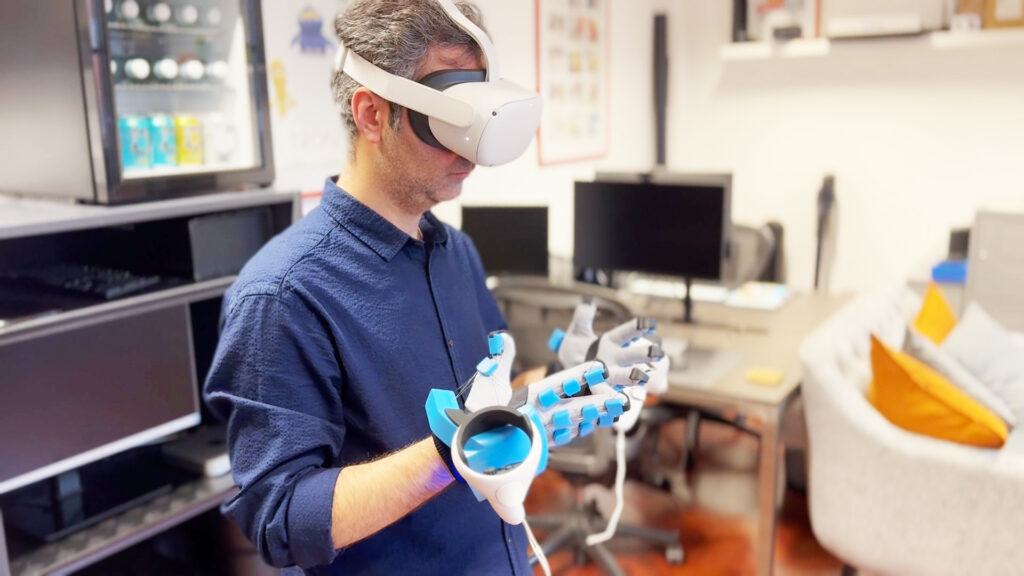Training Using Haptic Gloves Feedback In Realtime
Training using haptic gloves feedback in real-time is transforming the way businesses learn, train, and interact with their employees. The combination of virtual reality (VR) simulations and haptic technology enhances the immersive experience and is revolutionising the way we learn in virtual environments.
This innovative technology combines the power of VR with the tactile feedback of haptic gloves, providing users with an almost realistic experience that enhances understanding, learning and memory retention.
Such improved learning outcomes provide businesses with cost-effective training solutions. As immersive tech continues to evolve, we expect to see even more innovative uses and benefits across multiple industries. Haptics are not just a tool for training; they are a gateway to a new era of experiential learning and virtual interaction.
As a matter of fact, we’ve just completed a new project converting our VR Training for Cooks for use with a Senseglove. The content creates an engaging and retentive learning experience and bridges the gap between information in a textbook, and cooking in a real kitchen.
The key goal in providing real-time feedback using haptics is to bring the learner closer to a real experience. Whereas controllers can generally be cumbersome, haptic feedback gloves are less intrusive and provide users with a ‘closer’ response.
Whilst the simulation experience does not provide an entirely real feel, a VR environment provides visual aids that show learners what to do, what to expect and what the result should look like. You cannot convey this level of information through textbooks.
In other training simulations using haptic gloves feedback, users can learn all the information they are aware of. For example, you can apply the weight of objects, the level of force you would need to apply to operate machinery, where to position a drill or knife etc. The options are endless.
Understanding Haptic Gloves Feedback
Haptic gloves are wearable devices equipped with sensors and actuators that simulate the sense of touch by providing users with tactile sensations such as vibrations, pressure, and texture.
When paired with a VR headset, the feedback from haptic gloves creates a more immersive and realistic training environment. The experience is more engaging for trainees because it stimulates sensory nerves by adding touch to sight and sound.
When interacting with virtual objects, users can feel the weight, shape, and surface characteristics of these objects. This tactile feedback adds realism to the virtual experience, making it more engaging and memorable.
Real-time haptic feedback enhances the sense of immersion in virtual environments. Users can feel the impact of their actions, such as the recoil of a gun or the resistance of a virtual object.
Therefore trainers are able to create a myriad of customisable scenarios tailored to specific learning objectives. This allows users to practice a wide range of tasks and scenarios in a controlled and safe environment. Not only do employees learn faster, they are not placed in a situation where they can cause injury to themselves or others, or damage your business reputation.
Immersive tech also eliminates the need for physical equipment and resources. This not only means that you eliminate ongoing costs associated with traditional training methods, but you can also train staff remotely and eliminate the need for travel during the training period.
Learning By Doing
By engaging the sense of touch, haptic gloves enhance the overall sense of immersion in virtual environments. Users feel like they are physically interacting with objects, which increases their sense of presence and realism.
As a result, the tactile response provided by haptic gloves reinforces learning by engaging multiple senses. This heightened immersion makes the learning experience more compelling and effective.
Studies have shown that multisensory learning leads to better retention and understanding of information and concepts. When users can both see and feel virtual objects, their brains create stronger connections and memories associated with the learning material.
Learning by doing also helps to give trainees more confidence. For example, if a user is practising a surgical procedure, they can feel the resistance and texture of tissues as they make incisions.
Interacting with virtual objects using haptics requires users to use their hands and fingers in a precise manner. This helps in the development and refinement of fine motor skills, such as dexterity and coordination. This comes in useful for jobs that require manipulation and precise movements such as construction, surgery, sports, manufacturing and engineering.
Get in touch
Training using haptic glove feedback is a great way for your employees to expedite their learning experience and boost their confidence. Get in touch today and discuss how VR training can enhance your workforce.










